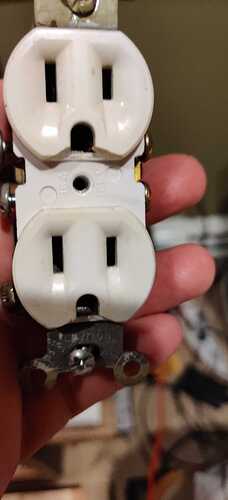I took advantage of their recent sale and pulled the plug on this. Have it in for a few days now. Before sharing any thoughts, use at your own risk. Assuming you use the sdfb per their instructions, you’ll probably be fine. But not trying to convince anyone and all that. I’m personally using the box, and yes it’s annoying that you need another power cable, but it is what it is.
Now that the disclaimers are out…
I’ll only talk about the slugs since the box is there for protection, so it’s not the thing contributing sonically. I tried 2 of their gold-plated copper slugs (streamer/external psu) and 2 of their latest graphene slugs (dac/amp). To get the copper slugs out of the way, yes, I’d choose this over a hi-fi tuning or synergistic research purple fuse any day (which they replaced). But the star of the show is the graphene slug.
Initial impression: WTF is this sensory overload?! This is NOT subtle  ! I was surprised how much of an improvement this was. It was like getting a new DAC or power distributor; it was that drastic. Just to clarify, the big improvement happened after the whole system was “slugged.” Individually, they make good improvement but wasn’t that drastic.
! I was surprised how much of an improvement this was. It was like getting a new DAC or power distributor; it was that drastic. Just to clarify, the big improvement happened after the whole system was “slugged.” Individually, they make good improvement but wasn’t that drastic.
The biggest thing that caught my attention was how it made the headphones “disappear.” It’s like there’s a sonic sphere surrounding your head which made the staging all the more convincing and involving.
As impressive as this sounded initially, after a few songs, I thought to myself that I’d probably grow tired of this “staging party trick”… and it was also getting a little fatiguing because of all the energy coming through. Still… that initial impression was a big shock and wow moment.
Couple sessions later: The sound is now more focused and refined, the harshness and excess energy are gone, and the staging sounds natural now, and not enhanced. The headphones still “disappear” but now the sound is settling in very nicely. It’s still a drastic improvement I can’t wrap my head around.
Standouts:
-
Staging - the depth, scale, and holographic-ness are all  . the transducers disappear and you’re left with a fairly convincing illusion of being “in” the music; it’s so immersive.
. the transducers disappear and you’re left with a fairly convincing illusion of being “in” the music; it’s so immersive.
-
Headroom - lots of it… you can crank it up high and not lose composure or control. it feels like there’s so much power in reserve which makes the music sound so “free.” I was listening to ‘I know a name’ (elevation worship) and in that track there’s a choir in the background. the sense of power and grandeur that’s projected at you really adds to the listening experience, and I’m fairly familiar hearing choirs from the church I frequent (building is huge vertically). to experience something similar to that within headphones…  (obviously it’s still inside your head)
(obviously it’s still inside your head)
-
Bass - deep, authoritative, and dynamic… I listened to ‘Itteresshai’ (ai higuchi) and the ‘Poem of chinese drum’ (thanks for mentioning @SaberPunch), and it was just wow on the yammy hps. the low frequencies pulsating, pressurizing, and slamming your ears with such vigor and dynamism… I knew the bass on the yammy were already extremely capable, but I didn’t expect it to scale as much as it did and surpass any expectations I had. bloody spectacular bass, not sure what else to add.
-
Tangibility - texture, texture, and even more texture. the ability to delineate/outline the intensity of each hit, strike, pluck, breath, etc… adds a lot to the feeling of being able to physically “touch” the music in thin air. whole lot of subjective jargon here, but you’ll just have to experience and try it out for yourself. Sorry, I don’t think I can articulate any better than this.
TLDR: Sonically, a big no-brainer imo. The graphene slugs improved every single aspect without shifting tonality and adding colour, unlike my experience with the SR purple fuse (which isn’t necessarily a bad thing). It also extends the frequency response on both ends and noticeably adds more immersion to the listening experience. I’ve not compared it to a loom of same-branded fuses so maybe for another’s system that could work out better for you, but based on what I’m experiencing on mine I’m not curious to experiment with fuses any longer… whatever color SR decides to push out next lol.
